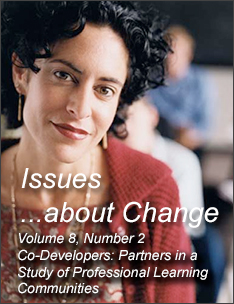External Facilitators and Field-Based Developers in their Schools
At the earliest stages of the project, SEDL encouraged Co-Developers to begin considering a school with which they would work in developing a PLC. Co-Developers held discussions at the meetings about whether to select a school that seemed to be at a high level of readiness for such change, or to select a school that appeared to be at a low-readiness stage.4
It was finally decided to give Co-Developers the option of selecting the school they wanted to work with regardless of its apparent readiness. Allowing Co-Developers to make this decision based on individual and collective knowledge, reflection, assessment and intuition modeled the shared and supportive leadership that forms the foundation of PLCs. In SEDL's view, having schools representing a broad range of readiness would also offer knowledge about how PLCs are created along the full spectrum of readiness for change. Throughout this time, SEDL continued to give extensive attention to equipping Co-Developers with skills to prepare them for work at their target schools.
Also during this time, the ranks of Co-Developers were trimmed by the pressures of "real life" (new job assignments, illness, family circumstances). In the end, twenty-two Co-Developers entered twenty-two schools that varied not only in readiness for change, but also in regional location, ethnicity, and grade levels.
In September 1998, Co-Developers invited the principal and a teacher (hereinafter referred to as the "lead teacher") from their school to accompany them to a SEDL conference in Austin. This meeting introduced the concept of PLCs to campus-based individuals and engaged these professionals in the dialogue, discussion and shared responsibility for introducing—and practicing—PLC principles in their schools.
Co-Developers collaborated in planning this conference and took an active role in leading various parts of the meeting. The conference provided time for many of the Co-Developers to get acquainted with their principals and lead teachers and offered an opportunity for these Co-Developer/principal/lead teacher "trios" to plan how they would present the project to their school staffs when they returned to their campuses. The meeting also offered some tools, strategies and processes for getting started.
These experiences fed Co-Developers' intuition, understanding, and compassion as they worked with school personnel who were at times resistant, hostile and/or fearful of change and responsibility. The meeting also provided opportunities for Co-Developers to reflect upon various ways to apply their new learning and expertise, and to make a concrete plan for how they would use each proficiency.
At the close of the September 1998 meeting, SEDL provided each participant with a large binder of strategies related to the proficiencies the Co-Developers had identified, designed, and shared as necessary to creating PLCs. Almost all of these strategies had been used in some manner with the Co-Developers (and some with the principals and lead teachers) in preparation for their work in schools.
Furthermore, at all meetings, SEDL modeled principles of professional development that research supports for adult learners. SEDL also provided opportunities for Co-Developers to reflect on use of specific strategies (e.g., dialogue) for different purposes. Although at this time only a prototype of a final product, this set of strategies provided useful tools and information for Co-Developers' work with their schools.
To further support Co-Developers in their work at schools, SEDL staff members from the Strategies for Increasing School Success (SISS) program were assigned to Co-Developers to offer assistance on issues that developed at schools. Each SEDL staff member worked with five to seven Co-Developers and served an important function in supporting Co-Developers by listening to their frustrations, acting as sounding boards for some of their ideas about their work in their schools, and suggesting new and innovative ideas.
Frequent email and telephone contacts made it possible for SEDL staff to respond quickly and efficiently to questions and concerns of Co-Developers. SEDL staff also identified journal articles, Internet Web sites, laboratory personnel, and other resources to locate research-based approaches related to Co-Developers' issues as they worked with their schools.
Next Page: Contributors to Applied Research

